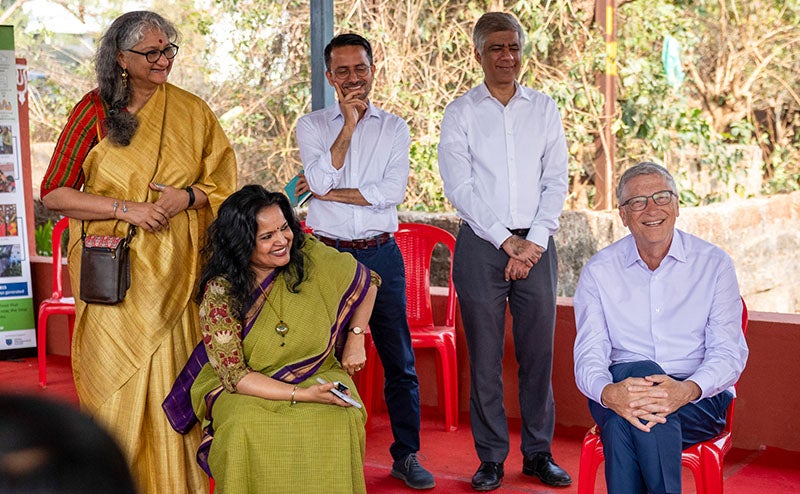I don’t think you need to be a hardcore gamer to enjoy Gabrielle Zevin’s terrific novel Tomorrow, and Tomorrow, and Tomorrow.
When Paul Allen and I started Microsoft, we had an ambitious goal: to put a computer on every desk and in every home. A lot of people thought we were out of our minds. But we believed in the power and potential of these machines to change the world. So every day, we came to work determined to make it happen. Now, it’s hard to imagine the world any other way. In a few short decades, that goal became reality for billions.
In 1990, the possibility that the world would be able to cut child mortality in half over the next thirty years would have seemed just as remote. But that’s exactly what happened. And I believe the world can do it again by 2040—we can cut child mortality in half once more—and get even closer to ending all preventable child deaths.
My introduction to this issue came 27 years ago, when I read a piece in the New York Times about deadly drinking water in the world’s poorest countries that contained the following statistic: “Diarrhea kills some 3.1 million people annually, almost all of them children.” Learning that shocked me to my core. There’s no greater pain than the death of a child. The death of millions of them—from something easily treatable in much of the world—is tragedy after tragedy on an almost unfathomable scale.
Before long, I was learning everything I could about global health generally and child mortality specifically. And shortly after, the Gates Foundation, which was just getting off the ground, made it our mission to fight preventable health disparities like this around the world—with an emphasis on children whose lives were being cut short before they ever had a chance.

We had phenomenal partners in that effort across governments, in the private sector, and from foundations and organizations that share our mission. And by 2019, something remarkable had happened—what I consider to be one of the most important things humanity has ever achieved: In under three decades, child mortality was cut by more than half. (For more about how this happened, and all the partners who deserve credit, see my blog post from two years ago.)
Measles deaths fell 90 percent thanks to vaccines. Pneumonia deaths fell 70 percent, also thanks to vaccines. Deaths from diarrhea—which killed 3 million kids a year not too long ago—fell 70 percent, too, thanks to low-tech interventions like oral rehydration solution, large-scale sanitation programs, and (yes, you guessed it) a new rotavirus vaccine. Malaria deaths fell 36 percent thanks to effective bed nets and sprays. Even deaths from HIV, which more than tripled as a killer of kids in the 1990s, fell 33 percent once we figured out how to protect and treat mothers so they don’t pass the virus on to their babies.

It wasn’t just the child mortality rates from these diseases that went down, though. Year after year, the raw number of overall childhood deaths fell—even as the global population rose—from 12 million in 1990 to five million in 2019.
We’ve made incredible progress, and we keep moving in the right direction. But we aren’t moving fast enough. Just under five million kids still die each year before reaching their fifth birthday. Another two million are stillborn. Virtually all of these deaths occur in low- and middle-income countries—and every single one is a tragedy that devastates families and entire communities.
My blog post from two years ago told the first part of this story—explaining what we know about child mortality and what we did to cut it in half once before. This is part two: how we can cut child mortality in half again, to below three million deaths a year by 2040.
The main reason I believe we can do this is because we already have most of the tools we need. As we shared in last year’s Goalkeepers Report, “Researchers have learned more about the health of mothers and babies over the past 10 years than they did in the century before that.” While continued innovation is always necessary, we currently have the know-how to save millions of lives—it’s a matter of putting it to use and making sure it reaches the children who need it most.
That begins before children even take their first breaths. It begins with mothers.
When a mother dies during childbirth, her child has a more than 63 percent chance of dying before their first birthday. To save those kids’ lives—and so many others by 2040—we need to focus on keeping women healthy before and throughout pregnancy, so they can deliver and raise healthy children.
Stop women from bleeding to death after childbirth
Around the world, postpartum hemorrhage (PPH)—defined by the WHO as losing more than half a liter of blood within 24 hours of childbirth—is the primary cause of maternal mortality. Often, it isn’t caught until it’s too late, because it’s hard to know how much blood loss is too much.
But with a low-cost tool called a calibrated obstetric drape and a trained birth attendant monitoring it, blood loss can be accurately measured in real time. By bundling five interventions that stop the bleeding and administering them simultaneously rather than sequentially—an approach known as E-MOTIVE—healthcare workers can slash cases of severe bleeding by 60 percent. By screening for and treating anemia, a common cause of PPH, during pregnancy, the world can prevent some PPH cases entirely.
Prevent life-threatening infections during labor
Sepsis—a life-threatening condition in which the immune system overreacts to an infection, causing widespread inflammation and organ damage—is another common cause of maternal mortality. In the U.S., it’s responsible for 23 percent of cases. But researchers have recently discovered that azithromycin, one of the world’s most common antibiotics, can reduce sepsis cases by a third when given preventatively. This discovery will be lifesaving for mothers—and therefore babies—especially in places where many women give birth at home, in conditions that aren’t necessarily sterile.
Speed up the development of babies’ lungs
When babies are born pre-term, before 37 weeks of pregnancy, their organs are still under-developed—especially the lungs, one of the last organs to finish growing inside the womb. That leaves these babies vulnerable to a whole host of potentially fatal complications. But now, if doctors learn a mother is at risk of going into pre-term labor, they can prescribe her antenatal corticosteroids that help her baby’s lungs grow as much as they would over a few weeks—in just a few days.
Fight malnutrition before and after birth
Without a healthy microbiome—the universe of bacteria inside the gut—babies struggle to absorb the nutrients in breast milk no matter how much they’re fed. That malabsorption is doubly destructive because it can lead to malnutrition, which can leave babies more susceptible to contracting and dying from pneumonia.
While experts used to believe that malnutrition could only be treated at around six months—once a baby starts eating solid foods—we now know that the microbiomes of mothers and babies are connected. That means micronutrient supplements can be given to pregnant women; when they are, babies gain an additional 5 grams of weight each day during the late stages of pregnancy and are more likely to be born with a healthy gut.
And when a baby is born underweight or pre-term, probiotic powders that include bifidobacteria can be added to breast milk to improve their digestive system, help them absorb nutrients, and reduce their risk of contracting severe infections and dying.
The focus, with each of these interventions, is on the beginning of a newborn baby’s life (and the lead-up to it). Why? Because half of all deaths of children under five occur in the first 28 days. If a baby is born healthy and survives that first month, the odds increase dramatically that they will live to see their fifth birthday—and then onto adulthood. Making this happen will require renewed investments by governments and organizations around the world to get these life-saving interventions out to the people and places where they’re so sorely needed. But it doesn’t require much new invention. Again: The solutions to cut child mortality in half again already exist. (And they’re all low-cost.)

Of course, there’s still much more to do to eliminate preventable deaths of children altogether. We need to continue improving sanitation and increasing access to clean drinking water around the world. We need to develop a vaccine for HIV and next-generation malaria vaccines to really stop them in their tracks; as we saw over the last 30 years, diseases with effective vaccines declined much faster than those we try to control without them.
We also need to ramp up vaccine distribution efforts, with an emphasis on reaching the 60 million “zero-dose” kids in lower-income countries who’ve never received a single immunization and now make up half of all childhood deaths from diseases with effective vaccines. These numbers spiked during the pandemic, when routine immunizations were disrupted and vaccine misinformation surged. Fortunately, Gavi, the Vaccine Alliance—which has helped vaccinate over 981 million children in the world’s poorest countries since 2000—is working around the clock to reach these kids. The organization will be having its next replenishment cycle soon, and the more money raised, the more lives saved. I often say that giving to Gavi is the best investment I’ve ever made.
None of this work is easily accomplished. Most goals worth achieving aren’t, though, especially one as important as this. But with the right commitment, I think preventable child deaths will one day be as unimaginable to us as life without computers. And in the not-too-distant future, a world where all children have the same chance to survive and thrive—no matter where they’re born—will become reality, too.




